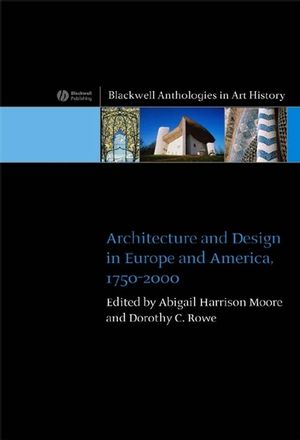|
Textbook
Architecture and Design in Europe and America: 1750 - 2000ISBN: 978-1-4051-1531-5
Paperback
544 pages
April 2006, ©2006, Wiley-Blackwell
 This is a Print-on-Demand title. It will be printed specifically to fill your order. Please allow an additional 15-20 days delivery time. The book is not returnable.
Other Available Formats: Hardcover
|
||||||
List of illustrations.
Introduction: Dorothy C. Rowe and Abigail Harrison Moore.
i. The Architectural Plates from L’Encylopédie.
Denis Diderot (ed.) (1751-1780).
ii. ‘The Plates of the Encyclopedia’ (1964).
Roland Barthes.
iii. Introduction’ from The Archaeology of Knowledge (1969).
Michel Foucault.
Part I: Knowledge, Taste and Sublimity, c.1750-1830.
Introduction: Abigail Harrison Moore.
1. Palladian Permeation: The Villa: John Summerson.
2. The Country House: Form, Function and Meaning: Dana Arnold.
3. Plans and elevations for the villa of Lord Mansfield at Kenwood (illustration): Robert and James Adam.
4. Lectures on Architecture: Sir John Soane.
5. Extracts from A Description of the Villa: Horace Walpole.
6. Thomas Jefferson: James Ackerman.
7. A Philosophical Enquiry into the Origin of our ideas of the Sublime and Beautiful: Edmund Burke.
8. On Architecture and Buildings: Uvedale Price.
9. An Analytical Inquiry into the Principles of Taste: Richard Payne Knight.
10. Introduction: Iconography and Landscape: Stephen Daniels and Denis Cosgrove.
11. The Plates and Elevations of John Nash: John Summerson.
12. Architecture, Essay on Art: Etienne-Louis Boullée.
13. The Sphere: Reading a gender Metaphor in the architecture of modern cults of identity: Suzanne von Falkenhausen.
14. Karl Friedrich Schinkel: David Watkin and Tilman Mellinghoff.
15. Reading Architectural Herstories, The Disourses of Gender: Dana Arnold.
Part II: Urbanism, Reform and Revival c.1830-1910.
Introduction: Abigail Harrison Moore and Dorothy C. Rowe.
16. From Contrasts.
The City in 1440 and The City in 1840 (illustration).
17. An Apology for a work entitled Contrasts: A.W.N. Pugin.
18. Lecture X: Eugene-Emmanuel Viollet-le-Duc.
19. Science, Industry, and Art: Gottfried Semper.
20. The Age of Gothic: John Ruskin.
21. The Revival of Architecture: William Morris.
22. G, Some Recent Designs by Mr. Voysey.
23. Style: Louis Sullivan.
24. Ornament in Architecture: Louis Sullivan.
25. The Tall Office Building Artistically Considered: Louis Sullivan.
26. Plasticity: Frank Lloyd Wright.
27. The Nature of Materials: Frank Lloyd Wright.
28. Fire Proof House: Mary Lucy Mahony Griffin.
29. Women Architects: Lynne Walker.
30. The programmes of the architectural section of the École des Beaux-Arts, 1819-1914: Annie Jacques.
31. Adler and Sullivan at the 1893 World’s Columbian Exposition in Chicago: Zeynep Çelik.
32. Public Parks and the Enlargement of Towns: Frederick Law Olmsted.
33. Chapter 6 Paris as the Hub of French Industrialisation: Building a European Capital Under the Second Empire 1852-70: Anthony Sutcliffe.
34. Introduction and Chapter I: The Town-Country Magnet: Ebenezer Howard.
35. Chapter VIII: The Meager and Unimaginative Character of Modern City Plans and Chapter IX ‘Modern Systems: Camillo Sitte.
36. Construction: Otto Wagner.
Part III: Architecture For Tomorrow c.1910-2000.
Introduction: Dorothy C. Rowe.
37. “Ornament and Crime” and “Architecture”: Adolf Loos.
38. Manifesto of Futurist Architecture: Antonio Sant’Elia.
39. The Turbine Hall of the AEG: Peter Behrens.
40. The State of German Architecture: Sigfried Giedion.
41. Programme of the Staatliche Bauhaus in Weimar: Walter Gropius.
42. Letter to the younger generation: Marianne Brandt.
43. Chapter IV: Space (architecture): László Moholy-Nagy.
44. “Where do we Stand” Lecture delivered in Zurich, Switzerland.
Marcel Breuer.
45. The Years in Berlin, 1919-1933 and extracts from chapter 2 Eric Mendelsohn.
46. Solved Problems: A Demand on Our Building Methods and Explanation of the Educational Program: Mies van der Rohe.
47. Report of the De Stijl Group at the International Artists’ Congress in Düsseldorf: Theo van Doesburg.
48. Towards a New Architecture: Le Corbusier.
49. Architecture in everything, City Planning in Everything: Le Corbusier.
50. On discovering Gaudi’s Architecture: Le Corbusier.
51. The Split Wall: Domestic Voyeurism: Beatriz Colomina.
52. Nine Points on Monumentality: José Luis Sert, Fernand Léger and Sigfried Giedion.
53. Monumentality: Louis I. Khan.
54. Reaffirmation of the Aims of CIAM.
55. Introduction – The Machine Age and Conclusion: Functionalism and technology: Reyner Banham.
56. The Death of Modern Architecture: Charles Jencks.
57. Towards a Critical Regionalism: Six Points for an Architecture of Resistance: Kenneth Frampton.
58. The Pleasure of Architecture: Bernard Tschumi.
59. Scale and Span in a Global Digital World: Saskia Sassen.
Bibliography.
Index



